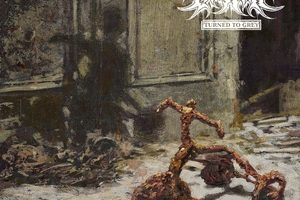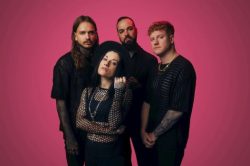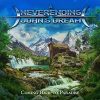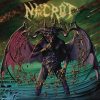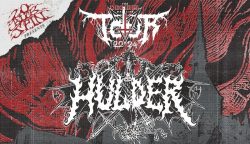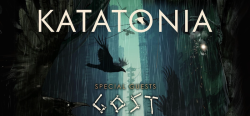Livekill – One Step Ahead
Wednesday, 26th September 2018
With a stunning cover, high quality production, and a killer drum session in tow, LiveKill don’t exactly have the start you’d think of with a fresh act. It’s quite clear that they mean business, and the music behind them echoes the same sentiment. Metallic to the bone, but the combination of groove and melody give the band some wiggle room as they continue to progress. We grabbed guitarist John Snell for a round of questions, including some background on the band, how to stand out as a new group, and what they are up to in order to stay relevant.
Dead Rhetoric: Where does the name LiveKill come from?
John Snell: LiveKill is an old name that I’ve used for a while as my online gaming name. When I played games online I would play as “Live2Kill,” so I dropped the number 2 and as I started playing music and we decided to use it as the band name.
Dead Rhetoric: What do you feel best describes LiveKill as a band?
Snell: We are just a straight, in your face type of metal band. Kind of like Hatebreed. Guitar riffs, drums, vocals – there’s not a lot of lead playing; I like to write harmonies in the guitar riffs. It’s just metal.
Dead Rhetoric: What do you feel makes you stand out?
Snell: I think what makes us stand out are two things. One is the way that Carlos [Guerreros] writes the vocals and the way he sings them. He doesn’t really write vocals that goes with the guitar riffs. He kind of sings over the top of the guitar riffs. I’ll have riff 1, 2, 3, bridge, chorus and I’ll assume he is going to write vocals in a certain spot. When I get them back, he really brings the song to life when he is singing over the top, bringing two different riffs together to make it one song. I like the way he does what he does.
The second thing, when we play live, Carlos is insane. He’s anywhere but in the center of the stage. If there’s somewhere for him to climb, like the PA speakers or in the crowd, he’s all over the place, so we stand out live with our performance. The writing process is also good for how we go through it.
Dead Rhetoric: Do you think that with the live presence, it helps with your name as well?
Snell: Yeah. Nobody has really asked that, but yeah, we are going to kill it live. With that name and having that perception, the idea is that we try to bring a lot of energy to the stage when we are playing.
Dead Rhetoric: Could you talk about the cover and the overall EP concept.
Snell: The whole concept of Turn to Grey, the artwork, done by Eliran Kantor, was that I went to him with the idea – he’s done other big names like Testament, Sodom, Soulfly, and Hate Eternal. He came back and he told us that no one had ever come up with an idea like that, and that he was down to do the artwork for us. He thought it was great. So he did the research and found the story about the kid and the tricycle, and how he died. He brought it back to me and said that he knew that this was our concept – people were vaporized, but he found this story and asked us what we thought. I felt it was exactly what I was looking for. I was trying to capture, in the music/song/artwork, that life is short. It’s about life – it’s about living, it’s about getting out there. That’s what metal is all about. Metal is energy, it’s aggression, it’s getting out there.
When he came back with the art design – the tricycle, the shadow, the kid not there – a lot of people think it’s a ghost. I explain it as the bomb went off – this is what’s left. Who was the kid? Having the story, it’s a real story. The tricycle is in a museum, you can look that stuff up. It’s really cool. It really inspired me. I went to Carlos and asked what he thought about it and he thought it was awesome. He wrote the lyrics to Turn to Grey. The whole thing ties together. LiveKill, Turn to Grey, the shadows, it all works really well for us.
Dead Rhetoric: Do you feel that basing the EP on a real event gives it a greater impact or depth?
Snell: The impact and the depth that I was aiming for was, there’s a thousand bands just in our local scene, how do you stand out? How do you stand out from everyone doing the same thing? How do you be different? If it’s not different, why do it? So to have that idea of people seeing the artwork and what it’s about – Turn to Grey…you are nothing but ashes in ½ a second. That’s the idea. They see it and they move on with their day. At the end of the day, during their quiet time, in those last thoughts before going to bed, I wanted that image to sit with you and let you think about it. I wanted something to stick.
Dead Rhetoric: It definitely does. It goes in a different direction for artwork. There’s nothing fantastical or over-the-top, it’s a solid image that will stick with you.
Snell: It’s an image that when you look at it, and look again, it makes you wonder. It makes you think about what was really going on there. That’s what I wanted.
Dead Rhetoric: There’s a lot of larger name people involved with the recording/production/artwork. Do you feel that you need to really hit the ground running with this first release?
Snell: I really didn’t want to mess around. I wanted a quality product. I wanted everything done for a purpose, on purpose. I wanted to catch the listener’s attention. I wanted to catch attention visually. I didn’t want my buddy drawing me a picture at Starbucks and saying “Hey, here’s your artwork.” I wanted quality in the recording, from the production to the mastering to the artwork to the merch. Everything needed to be really good.
Dead Rhetoric: You mentioned the songwriting earlier. Could you go into more detail on that approach?
Snell: Writing music, for a long time, has been that everyone gets in a room, and someone has an idea and everyone starts jamming to it. You spend a lot of time saying, “I don’t like that, let’s do this instead.” For me, what works is to write all the guitar riffs out. I program them in Guitar Pro. I put it in there exactly how I would play them, and put fake drums to it to get an idea of what it sounds like. Then I send it to Carlos. It saves a lot of aggravation time, and it doesn’t waste the band’s time. It gets the idea to Carlos, and he can get me back the vocals. Then we can move things around in Guitar Pro and move things around to where it works better. Then we have a structure. Maybe 80-90% of what we want. Then I’ll record real guitar over it.
I hit up Kevin Talley (Chimaira/Daath/etc) for drums. He has this thing where you hit him up, talk to him and send him your tracks, and that worked great. He loved it; he recorded and sent me back tracks and I was able to finish re-writing guitars. You can’t get stuck when you write your riffs. When the drums come back, you need to be able to rearrange your riffs into what the drums came back as. The same with the vocals. Now that I had real drums, the guitars and vocals change a little and we track it all out. A friend of mine, he told me about Alastair Sims for mixing and mastering. So I hit him up and he liked it. It’s funny because it went from Florida to Texas, back to Florida, and to Canada and back to Florida all on files until you hear what we have. So my process is a little bit different than what most of the local bands are doing.
Dead Rhetoric: That also gives you an objective third party to look at things outside of the band members.
Snell: One thing that I’ve found with band members, is that if you come to them with an idea and you play it, and they don’t like it, no matter what I do to fix it they will never like it. They aren’t going to hear what I hear in my head. So if I go to the band after I go through this process, when they hear it, with the drums, guitar, and vocals, they are like, “Holy shit, that’s badass!” There’s a different perception in bringing it to the band all ready to go.
Dead Rhetoric: What’s your take on the Florida scene as a non-death metal band? I feel like I’ve been talking to more bands from there that aren’t just by the books death metal.
Snell: We are still king of the world for death metal, so there’s a lot of bands around here that are extreme metal. That’s all of our roots in the band, from our drummer Anthony to Sean, we all come from that and listen to it on a daily basis. But when it comes to playing the music, we wanted to do something different. It’s still heavy, it’s still got screaming in there. It’s got a little bit of melody that is going to stick with people. When you go home, you are going to remember it. It doesn’t sound like 6 songs that could be one long song – there’s some diversity in what we are playing.
I spent a long time, and went to a lot of shows and listened to the national acts coming through and the local acts playing. The one consistent thing was that they are all playing the same clubs, and the PA’s aren’t that great. You have all these killer musicians playing these insane riffs that are good and technical, you can’t hear it. You’ve lost the listener. You turn around and watch the crowd and everyone is texting and talking; they aren’t paying attention. So I wrote this music to move the back of the house the way that it does the front. To keep people’s attention. These songs were made to play live. The Florida death metal scene – I love it. That’s our roots, but playing live, this is the direction we are going for.
Dead Rhetoric: A lot of what we keep talking about comes back to standing out. What’s necessary to stand out as a band that’s growing in 2018?
Snell: You have to be committed. You can’t go to your show at the local bar and play your gig, then go back to cutting yards on Monday and expect people to care. Nobody cares. I saw a video that Ola Englund put out recently. It was a 2-3 minute clip, and everything I have been telling my band, he said it in the video the same way. To stand out, for me, would be the marketing is a bit different. It’s an EP, it’s four songs. Let’s get our feet wet and show people.
Let’s not take 12 songs and do a full length album that nobody cares about. You put all that time and effort into writing all these songs and no one is going to listen to them. Let’s do 4 songs and make them our best songs. Let’s put the money into quality recordings, quality productions, and quality artwork. For us, that’s how we stand out. The 4 songs we put out are the best they are going to be. So when you are on the radio listening to your music, and LiveKill is in the middle of your mix, it sounds like it’s supposed to be there. It belongs there.
Dead Rhetoric: That’s good too, because everything is shifting. There’s more EPs now, even just due to the average attention span.
Snell: Everyone is trying to figure out the new formula. What is the new formula to be in a band, metal or whatever, in order to get people to listen and care about what you are doing? So far, for us, a full-length doesn’t work. I like the EP. How do you release the EP? You spend 3 months promoting it, and releasing songs as you get closer. The EP is dropped, then maybe you have a few singles following it up. You go on tour and stay in front of people consistently with new material. That’s the difference.
Dead Rhetoric: Do you feel that with a 4-song EP having a full concept, does that make it feel more complete?
Snell: Definitely feels complete. I go back and look at EPs like Metallica’s first EP and that’s what they had. A lot of bands have 4 songs on an EP. It’s let’s put 4 out, and see what happens. Is it worth going on? Maybe it’s not? Why waste 2-3 years of your life and 10-20 thousand dollars getting to that point? Start with 4 songs. I want them to be the best they can be, like you said, complete. I got people to work on the album that know what they are doing. It’s a legit album, it’s good.
Dead Rhetoric: What are some of your goals as the band moves forward, either in the near future or further out? It seems like you have that rhythm figured out.
Snell: For us, we set goals and we try to achieve them as a band. The EP is going to release September 28th. We have a few shows with Hed PE and Doyle, and a few more after that. But we are focusing for summer 2019. Get the release going, get a few singles out, and then follow-up with that, so that when we hit the road, people will have an idea of who we are. Come out and see us!
Dead Rhetoric: So your songs are catered to the live performance. As you gain more live experience, do you think it will help you hone in on what works best?
Snell: Definitely. Going to local shows, seeing the national acts, and going to different clubs. We had Flotsam & Jetsam come through, and they played Pipers, which is not a big club. But to see how they sounded at that club, with the way they play and the way they write, versus how the music is projected in an amphitheater. Where are we going to be playing? How’s the sound going to be coming through? Will I lose the audience with my writing? Absolutely – the more places we play and get an idea of what sounds good in these clubs, eventually as we get to larger venues, it will be that much better.
Dead Rhetoric: In watching both the local and national acts, what are some things you’ve picked up and applied to the band?
Snell: Definitely in-ears. Being tight as a band using in-ears. It cuts out feedback through the PA when everyone is on in-ears. That seems to be a big thing that I notice in local acts to touring bands coming through. It’s a lot tighter and a lot cleaner.
Dead Rhetoric: What’s next after the EP release?
Snell: We have Hed PE and Doyle, that’s immediately. I’m also working on a couple singles now. I’m finishing writing and I’m looking to track them in the next month or so. Again, you want to be relevant, with current content, all the time. So if you aren’t in front of everybody with something new every couple months, they have already moved on. I saw one of these sites on the web with all the metal releases every Friday. There’s 30-40 albums every Friday. How do you stand out? Put out an album and do nothing for a year? No. I’ve got a single coming out. We have shows. We have another single coming out. We’ve got a lyric video. We are going to hit the road. So we have a regiment of goals to get done by June next year to stay in front of people.











